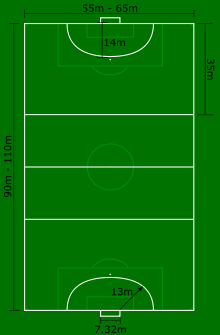Field handball

Field handball (also known as outdoor handball or grass handball) was the original form of what is now handball and was played at the 1936 Summer Olympics in Berlin.
The sport is played on a grass field (similar to an Association football field) between 90 and 110 meters long, 55 to 65 meters wide. The field has two parallel lines 35 metres from the goal line, which divides the field into 3 sections; each section can have up to 6 players of each team. The goal area is a semicircular line with a 13-metre radius, and the penalty mark at 14 metres from the goal. The goal is 7.32 meters wide and 2.44 meters high.
The game is played with the same ball as the indoor type by two teams of 11 players (plus 2 reserves) and two periods of 30 minutes each.
Indoor handball gradually grew in popularity to replace field handball and the last field handball World Championship was played in 1966.
There is no difference between this and regular team handball; just field handball is played outside.
See also
External links
- Handball at the Olympics
- Video 1 about field handball (in German)
- Video 2 about field handball (in German)
